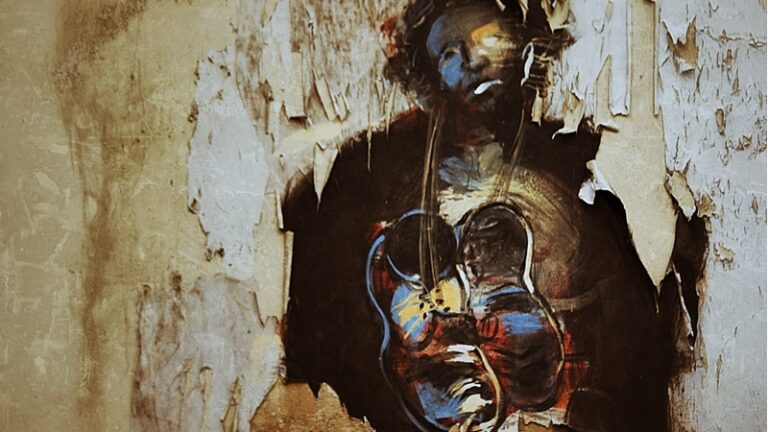wabi sabi and the broken face
The upper half of the head had been blown away, as had the entire back, just leaving the face below the eyes and down to the chin. From the corner of the right eye, running down the face, disappearing where the cheek formed a cleft with the mouth, was a single crack that looked like the path of a tear.
My mother, unknowingly to both of us, introduced me to wabi sabi when i was about sixteen years old. She was a deeply creative person who struggled with the technical aspects of her creativity. Her creativity was emotional and intuitive. There was nothing intellectual about it. At the time, she was exploring ceramics and throwing cups, jugs, bowls and vases on a potter’s wheel and making ceramic statues. The statues were of children or, more ambitiously, ceramic dioramas from Shakespeare’s ‘A Midsummer Night’s Dream‘. She’d studied set design in London and these three dimensional creations were, I think, the nexus of her beloved but distant childhood, frustrations from a never-pursued career and an inherent need to make things and stay busy.
I walked into her workshop one morning and stopped by the old galvanised iron bin that she threw rejects into – pots that had exploded in the kiln, busts where the likeness didn’t please her, or cups where the glaze had bubbled into weird pustules as if a medieval plague had been visited upon them.
Sitting on the top of the pile of broken attempts was half of a small child’s face. I picked it up and was immediately drawn to it. The upper half of the head had been blown away, as had the entire back, just leaving the face below the eyes and down to the chin. From the corner of the right eye, running down the face, disappearing where the cheek formed a cleft with the mouth, was a single crack that looked like the path of a tear. She explained that she had spent days getting the bust of one of her granddaughters ‘right’ and then it had exploded in the kiln leaving her frustrated and disappointed. I liked it. In it’s fragmented state it seemed to hold all the temporality, tenderness, innocence, happiness and unhappiness of being a child. The cracked path of the ‘tear’ was completely accidental, forged in the heat of the kiln, but deeply moving. It reminded me of an artefact from an ancient civilisation, hinting at a lost wholeness and of another time. It spoke more as a fragment than it could possibly have if it had left the kiln an unscathed, faithful replica of a family member. Now it resembled no one and everyone.
Decades later, I still have the Broken Face. It sits on my desk. And it still gives rise to the same feelings of melancholy, loss, and impermanence that I felt, but didn’t know how to articulate, when I was a teenager.
Months later my mother was grappling with glazing her pots. She found the mathematical precision required to get the glaze she wanted baffling and alien to her intuitive and impulsive way of working. To try and better understand the complex art of ceramic glazing she had bought a book on Japanese ceramics and discovered in its pages the concept of wabi sabi: pots, teapots, cups, plates, all deliberately left with cracks, crooked lips and glazing imperfections to produce the wabi sabi effect. The effect that gives rise, to a ‘serene melancholy and spiritual longing’ by acknowledging that ‘nothing lasts, nothing is finished, and nothing is perfect’.
My mother flew over the more intellectual and spiritual significance of wabi sabi. For her, it provided the rationale to save a good percentage of work that would otherwise be thrown away as too ‘imperfect’ and also offered her an explanation for her entire approach to creativity; her aesthetic (although this is a word that she would never have used.) For her it was the rough earthiness of clay rather than the smooth delicacy of porcelain. It was intuitive, organic, avoided attempts at perfection or sophistication, celebrated the rough and rustic and invited you to enjoy the simple and essential.
Wabi-sabi nurtures all that is authentic by acknowledging three simple realities: nothing lasts, nothing is finished, and nothing is perfect.
Richard Powell Tweet
Photo: © Tony Hughes, wabi sabi arrangement.
Of course, the expression of temporality, of impermanence, of beauty in simplicity, the celebration of the rustic and natural is not absent from the Western tradition. The Romantics celebrated it in poetry, painting and music. But the Western tradition often insinuates a thick layer of nostalgia, longing and loss whereas the wabi sabi expresses an atemporality where opposites and duality are resolved into a single reality – permanence and impermanence, beauty and ugliness, life and death, perfection and imperfection exist simply as expressions of a more fundamental singularity. Wabi sabi seeks to draw the observer of an object into this singularity without losing sight of the melancholic reality that is equally the material condition of all things and beings: the reality of coming into being, of change, of decay and a final oblivion.
If an object or expression can bring about, within us, a sense of serene melancholy and a spiritual longing, then that object could be said to be wabi sabi.
Andrew Juniper Tweet
Photo: © Tony Hughes, my mother’s accidentally wabi sabied bust.
“Wabi sabi is ambivalent”, Leonard Koren writes, “about separating beauty from non-beauty or ugliness. The beauty of wabi sabi is, in one respect, the condition of coming to terms with what you consider ugly. Wabi sabi suggests that beauty is a dynamic event that occurs between you and something else. Beauty can spontaneously occur at any given moment given the proper circumstances, context or point of view. beauty is thus an altered state of consciousness, an extraordinary moment of poetry and grace.”

